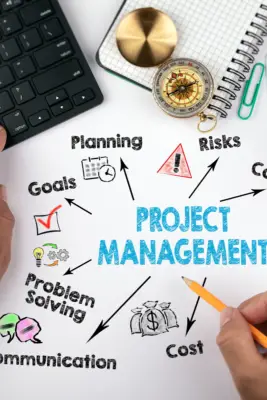A project management report is a formal document that provides stakeholders with critical information about a project’s progress, status, and direction.
It is an important tool for communication and accountability, allowing project managers to convey information about key aspects such as milestones, risks, issues, budget, and resource utilization.
Project management reports can take various forms, depending on the audience and the project’s complexity, including:
- Status Reports: Regular updates on the project’s progress, including what has been accomplished, what’s in progress, and what’s planned (Smartsheet).
- Progress Reports: Detailed insights into the project’s advancement against the schedule, often including percentage completion and any deviations from the plan.
- Risk Reports: Analysis of potential risks, their impact, and the mitigation strategies in place to address them.
- Resource Reports: Information on the allocation and utilization of resources, such as personnel, equipment, and budget.
- Financial Reports: Details on the project’s financial status, including costs incurred, forecasted costs, and overall budget health.
- Dashboard Reports: Visual representations of key project metrics and KPIs, providing a quick overview of project health.
The purpose of a project management report is to:
- Keep stakeholders informed about the project’s progress and any challenges faced.
- Provide data for decision-making to project sponsors and other decision-makers.
- Document the project’s history, which can be valuable for future projects.
- Ensure transparency and accountability within the project team and to external stakeholders.
- Enable early detection of issues, allowing for timely corrective actions.
Effective project management reporting requires regular updates and should be tailored to the audience’s needs, ensuring the information provided is relevant, accurate, and actionable.
Project management reports play a crucial role in the successful execution of projects. They provide valuable insights into project progress, identify potential risks, and help stakeholders make informed decisions.

From discussing the importance of project management reports to outlining key elements and tips for creating clear and concise reports, this discussion will explore how effective reporting can enhance project success.
Additionally, we will delve into the project management report format and its essential components, leaving you with practical knowledge to elevate your project management skills.
Key Takeaways
- Project management reports are essential for monitoring and evaluating project progress.
- They provide an overview of key project metrics like budget and timeline.
- Project management reports enable stakeholders to make informed decisions and take corrective actions.
- They are a valuable tool for project teams, stakeholders, and management.
The Importance of Project Management Reports
Project management reports are an essential tool for monitoring and evaluating the progress of a project. These reports provide an overview of key project metrics, such as budget, timeline, and scope, allowing stakeholders to make informed decisions and take corrective actions if necessary.
Definition of project management reports
The significance of project management reports lies in their ability to provide comprehensive and concise documentation of key project data and progress.
Project management reports are a valuable tool for the project team, stakeholders, and management to track the project’s performance.
These reports include information such as the project schedule, status reports, project milestones, project risks, project resources, project budget, and project completion report. They enable effective decision-making and facilitate communication among project stakeholders.
Importance of project management reports
Effective project management reports ensure success by providing comprehensive documentation and facilitating informed decision-making.
Project managers rely on project management reports to track progress, assess project health, and identify potential risks.
These reports, generated using project management tools, help managers communicate project status to stakeholders, including the project sponsor.
Project management reports facilitate effective communication and contribute to project success by providing a comprehensive project status report.
Key Elements of a Project Management Report
A project management report consists of key elements that provide crucial information for stakeholders.
These elements include:
- a project summary, which provides an overview of the project’s goals, timeline, and budget;
- a progress update, which highlights the current status of the project and any challenges encountered; and
- a risk assessment, which identifies potential risks and mitigation strategies.
Each element serves a specific purpose in ensuring effective project management and decision-making.
Key elements to include in a project management report
What are the essential components of a comprehensive project management report?
- Project plan: outlining the project’s goals, objectives, and tasks.
- The project summary report provides an overview of the progress, challenges, and achievements.
- Project timeline: illustrating the schedule and deadlines of key milestones.
- Resource utilization: evaluating the efficiency and allocation of resources throughout the project.
Including these elements in the project reporting process ensures an effective report accurately reflecting the project scope and facilitating decision-making.
Description and purpose of each element
To fully understand the components of a comprehensive project management report, it is important to delve into the description and purpose of each element.
These elements include:
- The identification of project goals and objectives.
- The documentation of project timelines and milestones.
- The analysis of potential risks and mitigation strategies.
- The tracking of project progress and current status.
- The identification of future projects and action items.
These elements serve as valuable sources of information for various types of project management and project reports.
Tips for Creating a Clear and Concise Report
One effective approach to ensuring clarity and conciseness in a project management report is prioritising precision and avoiding unnecessary verbosity. To create a clear and concise report, consider the following tips:
- Identify the project goal and key stakeholders.
- Clearly outline the project tasks and their deadlines.
- Provide regular updates on project progress and any potential project delays.
- Offer solutions and recommendations to overcome challenges.
Communicating Project Status to Stakeholders
Effectively communicating the status of a project to stakeholders is crucial for ensuring transparency and maintaining their engagement throughout the project lifecycle.
To facilitate efficient project reporting, project management report templates can be utilized to provide a comprehensive project overview.
Additionally, an action plan can be developed to outline upcoming tasks and allocate resources accordingly. Project managers can keep stakeholders informed using these tools and techniques and ensure the project stays on track.
Enhancing Project Success With Effective Reporting
To maximize project success, it is essential to implement effective reporting practices that keep stakeholders informed and engaged throughout the project lifecycle.
- A seasoned project manager ensures the entire project is monitored and reported on regularly.
- The reporting includes key aspects such as quality, risk profile, and resource management.
- A risk assessment report serves as a formal record of key indicators.
- Tailoring the reporting to the type of project ensures its relevance and effectiveness.
Project Management Report Format
The format of a project management report plays a crucial role in effectively communicating project progress and performance.
It is important to consider different formats that are commonly used in project management reporting and understand their pros and cons.
Common formats used for project management reports
Various formats are commonly used for project management reports. These formats serve as a communication tool for businesses to track and analyze project progress. The common formats include:
- Financial report: Provides an overview of the project’s financial aspects.
- Project performance report: Evaluates the project’s progress against its objectives.
- Project risk report: Identifies and assesses potential risks and their impact.
- Quality assurance report: Ensures that the project meets the required standards.
These reports are crucial in project management, providing insights into capacity, resources, and project closure.
Pros and cons of each format
Each format used for project management reports has its own set of advantages and disadvantages. The choice of format depends on the project type and the information that needs to be conveyed.
For example, a time-tracking report provides a quick overview of the project’s progress over a specific period, while a project closure template helps document the entire report effectively.
Project reporting templates can be customized to create meaningful reports and facilitate project change requests.

Components of a Project Management Report
Several components in a project management report convey the necessary information.
The executive summary provides a concise overview of the project’s current status, while the project background delves into the context and objectives.
Additionally, the stakeholder analysis identifies key individuals involved and their respective roles in the project.
These components collectively contribute to a comprehensive and informative project management report.
Executive summary: Providing a brief overview of the project and its current status
The executive summary of the project management report offers a concise overview of the project’s current status and progress.
- Quality standards and financial aspects are being closely monitored.
- Action items from the previous reporting period have been addressed.
- The source of truth for project information is regularly updated.
- Training and resource capacity has been assessed using the gap analysis report.
Note: The executive summary does not discuss the project background or objectives, as these will be covered in the next subtopic.
Project background: Describing the context and objectives of the project
The project background provides a comprehensive overview of the context and objectives of the project. It includes information on the team, task progress, and project efficiency.
Project portfolio management software generates reports on project status to streamline project reporting. Efficient resource allocation is facilitated through the use of time-tracking tools.
Additionally, project management certifications are crucial in ensuring the domain of quality assurance.
Stakeholder analysis: Identifying key stakeholders and their roles in the project
Key stakeholders and their respective roles in the project are identified through a thorough stakeholder analysis to ensure effective communication and collaboration throughout the project lifecycle.
- The project sponsor is critical in providing the necessary resources and support.
- The project manager is responsible for overall project coordination and meeting project objectives.
- The project team members contribute their expertise and work towards achieving project deliverables.
- External stakeholders such as customers, suppliers, and regulatory bodies may also significantly impact the project’s success.
Frequently Asked Questions
How Can Project Management Reports Contribute to the Success of a Project?
Project management reports are essential for the success of a project as they provide a comprehensive overview of the project’s progress, identify potential risks and issues, facilitate informed decision-making, and enable effective communication among stakeholders.
What Are Some Common Challenges Faced When Creating Project Management Reports?
Some common challenges when creating project management reports include gathering accurate and relevant data, ensuring clear and concise communication, addressing varying stakeholder needs, and managing time constraints to deliver timely and informative reports.
How Can Project Management Reports Help in Identifying and Managing Risks?
Project management reports help identify and manage risks by providing a comprehensive overview of project activities, highlighting potential areas of concern, and suggesting mitigation strategies. They enable stakeholders to make informed decisions and take necessary actions to mitigate risks.
What Are Some Best Practices for Effectively Communicating Project Status to Stakeholders Through Reports?
Effective communication of project status to stakeholders through reports is crucial for project success.
Best practices include providing concise and clear updates, using visual aids, addressing key concerns, and ensuring regular and timely distribution of reports.
How Can Project Management Reports Be Used to Improve Future Project Planning and Decision-Making Processes?
Project management reports are valuable tools for improving future project planning and decision-making processes. By providing a comprehensive overview of project performance, risks, and outcomes, these reports enable project managers to identify areas for improvement and make more informed decisions in future projects.

Conclusion
In conclusion, project management reports play a crucial role in ensuring the success of a project.
By providing key information and updates to stakeholders, these reports help in effective communication and decision-making.
Creating a clear and concise report is essential for conveying project status and progress.
By following a standardized format and including all relevant components, project managers can enhance project success through effective reporting.

Chris Ekai is a Risk Management expert with over 10 years of experience in the field. He has a Master’s(MSc) degree in Risk Management from University of Portsmouth and is a CPA and Finance professional. He currently works as a Content Manager at Risk Publishing, writing about Enterprise Risk Management, Business Continuity Management and Project Management.


